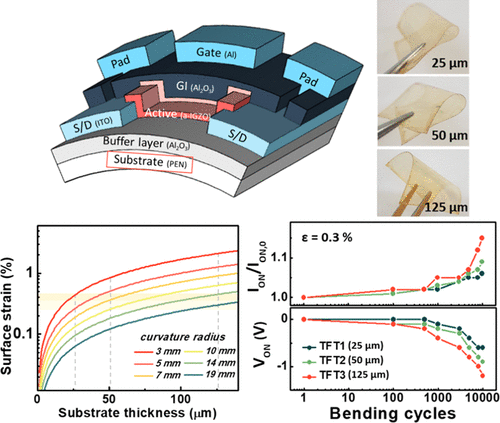当前位置:
X-MOL 学术
›
ACS Appl. Electron. Mater.
›
论文详情
Our official English website, www.x-mol.net, welcomes your
feedback! (Note: you will need to create a separate account there.)
Analysis of Mechanical and Electrical Origins of Degradations in Device Durability of Flexible InGaZnO Thin-Film Transistors
ACS Applied Electronic Materials ( IF 4.3 ) Pub Date : 2020-06-24 , DOI: 10.1021/acsaelm.0c00339 Hye-Won Jang 1 , Gi-Heon Kim 2 , Sung-Min Yoon 1
ACS Applied Electronic Materials ( IF 4.3 ) Pub Date : 2020-06-24 , DOI: 10.1021/acsaelm.0c00339 Hye-Won Jang 1 , Gi-Heon Kim 2 , Sung-Min Yoon 1
Affiliation

|
Mechanically flexible In–Ga–Zn-O (IGZO) thin-film transistors (TFTs) were fabricated and characterized on poly(ethylene naphthalate) (PEN) with various film thicknesses. The physical origins of mechanical and electrical degradations in device characteristics were extensively and systematically investigated under various mechanical strain conditions to improve the device operational reliabilities. To investigate the mechanical durability of the IGZO TFTs, the effects of PEN thickness on the variations in critical radius of bending curvature were analyzed, which were estimated to be 3, 7, and 14 mm, when the PEN thickness was 25, 50, and 125 μm, respectively. During the cyclic bending tests for the TFTs fabricated on 25 μm thick PEN, the operation cycles were estimated to be markedly reduced from 10 000 to 150 when the applied strain increased from 0.3 to 0.45% (critical strain), respectively. It was clearly suggested that the main origin for the device degradation under bending deformation could be altered from electrical to mechanical ones in the vicinity of the critical strain determined by critical radius of curvature. In other words, the evolution of microcracks and the variations in the density of states within the IGZO channel were found to have critical impacts on the device characteristics of the flexible IGZO TFTs above and below the critical strain, respectively. Consequently, the systematic analysis and the obtained results provided design guidelines and insights for implementing more mechanically robust devices in flexible electronics.
中文翻译:

柔性InGaZnO薄膜晶体管器件耐用性退化的机电原因分析
机械柔性的In-Ga-Zn-O(IGZO)薄膜晶体管(TFT)的制造和特征是在具有各种膜厚度的聚萘二甲酸乙二醇酯(PEN)上进行的。在各种机械应变条件下,广泛而系统地研究了器件特性中机械和电气性能下降的物理原因,以提高器件的工作可靠性。为了研究IGZO TFT的机械耐久性,分析了PEN厚度对弯曲曲率临界半径变化的影响,当PEN厚度为25、50和50时,估计分别为3、7和14 mm。分别为125μm。在以25μm厚的PEN制造的TFT的周期性弯曲测试中,当施加的应变从0.3升高到0.45%(临界应变)时,操作周期估计从10000显着减少到150。清楚地表明,在由临界曲率半径确定的临界应变附近,可以将弯曲变形下器件退化的主要原点从电气改变为机械。换句话说,发现微裂纹的发展和IGZO通道内状态密度的变化分别对柔性IGZO TFT在临界应变以上和以下的器件特性产生关键影响。因此,系统的分析和获得的结果为在柔性电子产品中实现机械上更坚固的设备提供了设计指南和见识。分别为45%(临界应变)。清楚地表明,在由临界曲率半径确定的临界应变附近,可以将弯曲变形下器件退化的主要原点从电气改变为机械。换句话说,发现微裂纹的发展和IGZO通道内状态密度的变化分别对柔性IGZO TFT在临界应变以上和以下的器件特性产生关键影响。因此,系统的分析和获得的结果为在柔性电子产品中实现机械上更坚固的设备提供了设计指南和见识。分别为45%(临界应变)。清楚地表明,在由临界曲率半径确定的临界应变附近,可以将弯曲变形下器件退化的主要原点从电气改变为机械。换句话说,发现微裂纹的发展和IGZO通道内状态密度的变化分别对柔性IGZO TFT在临界应变以上和以下的器件特性产生关键影响。因此,系统的分析和获得的结果为在柔性电子产品中实现机械上更坚固的设备提供了设计指南和见识。清楚地表明,在由临界曲率半径确定的临界应变附近,可以将弯曲变形下器件退化的主要原点从电气改变为机械。换句话说,发现微裂纹的发展和IGZO通道内状态密度的变化分别对柔性IGZO TFT在临界应变以上和以下的器件特性产生关键影响。因此,系统的分析和获得的结果为在柔性电子产品中实现机械上更坚固的设备提供了设计指南和见识。清楚地表明,在由临界曲率半径确定的临界应变附近,可以将弯曲变形下器件退化的主要原点从电气改变为机械。换句话说,发现微裂纹的发展和IGZO通道内状态密度的变化分别对柔性IGZO TFT在临界应变以上和以下的器件特性产生关键影响。因此,系统的分析和获得的结果为在柔性电子产品中实现机械上更坚固的设备提供了设计指南和见识。发现微裂纹的发展以及IGZO通道内状态密度的变化分别对柔性IGZO TFT的器件特性(在关键应变以上和以下)具有关键影响。因此,系统的分析和获得的结果为在柔性电子产品中实现机械上更坚固的设备提供了设计指南和见识。发现微裂纹的发展以及IGZO通道内状态密度的变化分别对柔性IGZO TFT的器件特性(在关键应变以上和以下)具有关键影响。因此,系统的分析和获得的结果为在柔性电子产品中实现机械上更坚固的设备提供了设计指南和见识。
更新日期:2020-07-28
中文翻译:

柔性InGaZnO薄膜晶体管器件耐用性退化的机电原因分析
机械柔性的In-Ga-Zn-O(IGZO)薄膜晶体管(TFT)的制造和特征是在具有各种膜厚度的聚萘二甲酸乙二醇酯(PEN)上进行的。在各种机械应变条件下,广泛而系统地研究了器件特性中机械和电气性能下降的物理原因,以提高器件的工作可靠性。为了研究IGZO TFT的机械耐久性,分析了PEN厚度对弯曲曲率临界半径变化的影响,当PEN厚度为25、50和50时,估计分别为3、7和14 mm。分别为125μm。在以25μm厚的PEN制造的TFT的周期性弯曲测试中,当施加的应变从0.3升高到0.45%(临界应变)时,操作周期估计从10000显着减少到150。清楚地表明,在由临界曲率半径确定的临界应变附近,可以将弯曲变形下器件退化的主要原点从电气改变为机械。换句话说,发现微裂纹的发展和IGZO通道内状态密度的变化分别对柔性IGZO TFT在临界应变以上和以下的器件特性产生关键影响。因此,系统的分析和获得的结果为在柔性电子产品中实现机械上更坚固的设备提供了设计指南和见识。分别为45%(临界应变)。清楚地表明,在由临界曲率半径确定的临界应变附近,可以将弯曲变形下器件退化的主要原点从电气改变为机械。换句话说,发现微裂纹的发展和IGZO通道内状态密度的变化分别对柔性IGZO TFT在临界应变以上和以下的器件特性产生关键影响。因此,系统的分析和获得的结果为在柔性电子产品中实现机械上更坚固的设备提供了设计指南和见识。分别为45%(临界应变)。清楚地表明,在由临界曲率半径确定的临界应变附近,可以将弯曲变形下器件退化的主要原点从电气改变为机械。换句话说,发现微裂纹的发展和IGZO通道内状态密度的变化分别对柔性IGZO TFT在临界应变以上和以下的器件特性产生关键影响。因此,系统的分析和获得的结果为在柔性电子产品中实现机械上更坚固的设备提供了设计指南和见识。清楚地表明,在由临界曲率半径确定的临界应变附近,可以将弯曲变形下器件退化的主要原点从电气改变为机械。换句话说,发现微裂纹的发展和IGZO通道内状态密度的变化分别对柔性IGZO TFT在临界应变以上和以下的器件特性产生关键影响。因此,系统的分析和获得的结果为在柔性电子产品中实现机械上更坚固的设备提供了设计指南和见识。清楚地表明,在由临界曲率半径确定的临界应变附近,可以将弯曲变形下器件退化的主要原点从电气改变为机械。换句话说,发现微裂纹的发展和IGZO通道内状态密度的变化分别对柔性IGZO TFT在临界应变以上和以下的器件特性产生关键影响。因此,系统的分析和获得的结果为在柔性电子产品中实现机械上更坚固的设备提供了设计指南和见识。发现微裂纹的发展以及IGZO通道内状态密度的变化分别对柔性IGZO TFT的器件特性(在关键应变以上和以下)具有关键影响。因此,系统的分析和获得的结果为在柔性电子产品中实现机械上更坚固的设备提供了设计指南和见识。发现微裂纹的发展以及IGZO通道内状态密度的变化分别对柔性IGZO TFT的器件特性(在关键应变以上和以下)具有关键影响。因此,系统的分析和获得的结果为在柔性电子产品中实现机械上更坚固的设备提供了设计指南和见识。











































 京公网安备 11010802027423号
京公网安备 11010802027423号